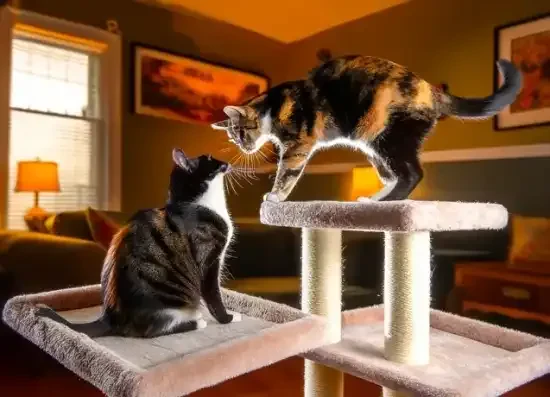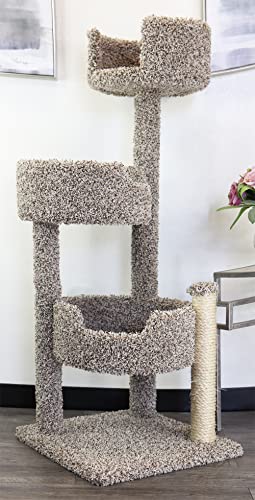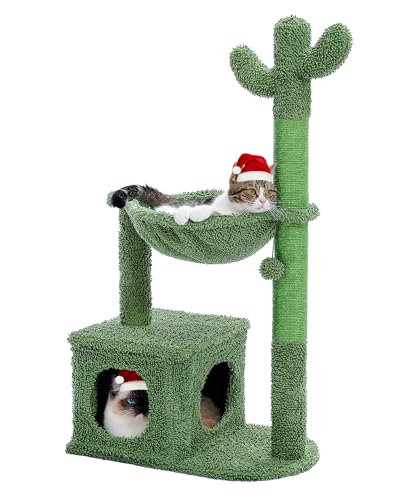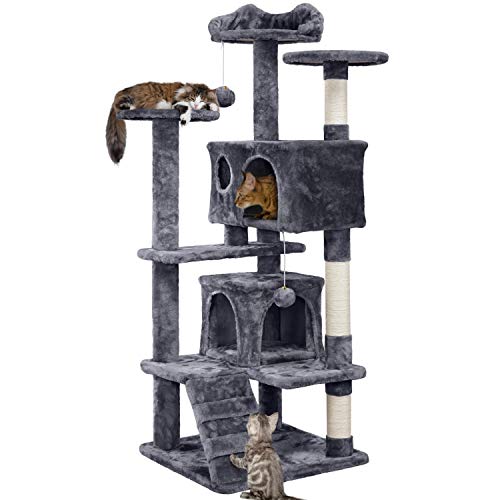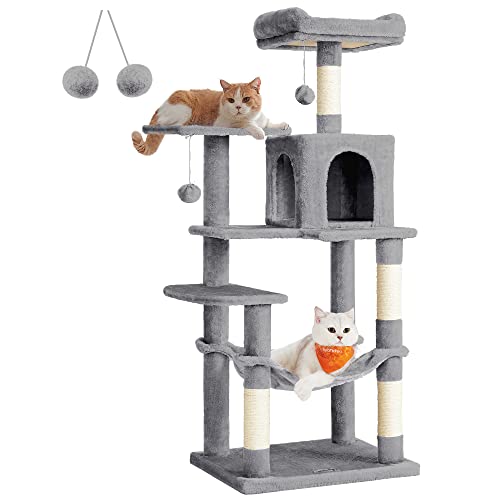Love cats, but perhaps less so the way they’ve redecorated your home, one claw mark at a time? Torn between your desire for a stylishly curated living space and your feline companion's innate need to climb, scratch, and survey their kingdom? You’re not alone. Many cat owners grapple with the same challenge: how to create a home that reflects their personal aesthetic while also being a comfortable and stimulating environment for their beloved cat. But what if we told you it’s not a compromise? What if you could have both?
Imagine a living room bathed in natural light, dotted with chic, minimalist furniture. Now picture, seamlessly woven into this stylish tableau, elegant floating shelves ascending the wall, not just for display, but as a feline highway leading to a plush window perch overlooking a vibrant garden. A textured sisal scratching post stands subtly beside the sofa, a deliberate design choice, not an afterthought. Soft, durable throws drape over furniture, adding a touch of bohemian comfort while protecting against the inevitable wear and tear of cat ownership. This isn’t a fantasy; it’s the reality of cat-friendly home décor, a philosophy that celebrates both style and feline comfort in equal measure.
This article is your guide to achieving this purr-fect balance. We’ll delve into practical, stylish, and comfort-focused solutions to transform your house into a home that both you and your feline friend will adore. We’ll explore the feline perspective, unraveling why cat-friendly décor is essential, before diving into the key design principles that form the foundation of this harmonious approach. From room-by-room inspiration to specific décor elements that blend functionality with flair, we'll equip you with the knowledge and ideas to create a space where style and feline contentment coexist beautifully. Finally, we’ll address the ongoing journey of maintaining this balance, ensuring a living environment that continues to evolve and cater to the needs of everyone under your roof, paws included. Get ready to embark on a journey to create a home that’s as chic as it is cat-approved.
To truly embrace cat-friendly décor, we must first understand the world through feline eyes. This isn’t merely about tolerating your cat’s quirks; it’s about actively catering to their deeply ingrained instincts and essential needs, creating a space that resonates with their very being. Imagine being a cat: your world is a tapestry of scents, textures, and visual stimuli, interpreted through a lens shaped by centuries of evolution.
Vertical space, for instance, isn’t a luxury for a cat; it’s a necessity. From the wild ancestors who sought refuge in trees to the modern housecat, the instinct to climb and perch remains deeply embedded. Vertical territory offers cats a sense of security, providing a vantage point to survey their domain, assess potential threats (or passing birds!), and establish a sense of control over their environment. It's not simply about reaching a higher level; it’s about gaining a new perspective, feeling safe, and claiming their space within the home’s hierarchy. Without adequate vertical opportunities, cats can feel insecure, anxious, and may resort to climbing furniture, curtains, or anything else that offers elevation, often to the chagrin of their owners.
Scratching, another seemingly destructive feline behaviour, is actually a vital form of communication and self-care. Cats scratch for multiple reasons: to maintain their claws by shedding the outer layers, to stretch their muscles, and, crucially, to mark their territory. Scent glands in their paws deposit pheromones with each scratch, leaving olfactory messages for themselves and other felines. Visually, scratching also creates markings that further delineate their claimed space. Denying a cat appropriate scratching outlets is akin to asking a bird not to fly; it goes against their very nature. Without designated scratching surfaces, cats will inevitably turn to furniture, carpets, and even walls, leading to frustration for both cat and owner.
Safe havens and retreats are equally paramount. In a world that can feel large and sometimes overwhelming, cats need sanctuaries – quiet, secure spaces where they can retreat, de-stress, and feel utterly safe. These aren't just about escaping loud noises or boisterous children; they fulfill a deeper need for solitude and security. Think of a den or a burrow – a place where they can feel hidden and protected. Without these sanctuaries, cats can become stressed, anxious, and even exhibit behavioural issues. A home without safe retreats isn’t just less comfortable for a cat; it can actively compromise their well-being.
Play and exploration aren't mere pastimes for cats; they are fundamental to their mental and physical enrichment. Cats are natural hunters, and even in the safety of a home, that predatory instinct persists. Play allows them to exercise these instincts, honing their coordination, reflexes, and mental agility. A stimulating environment, filled with opportunities to explore, pounce, chase, and solve puzzles, prevents boredom, reduces stress, and minimizes destructive behaviours born out of pent-up energy. A bored cat isn’t just an unhappy cat; it’s often a mischievous and potentially destructive one.
Finally, natural light and views hold a particular fascination for felines. Cats are inherently curious creatures, and the world outside the window becomes a captivating theatre of movement and life. Window perches aren't just sunny spots for naps; they are entertainment centres, offering a constant stream of visual stimulation as birds flit, squirrels scamper, and the world unfolds beyond the glass. Access to natural light is also crucial for their circadian rhythm and overall well-being. Denying a cat visual access to the outside world is like removing a key source of enrichment and engagement from their daily lives.
Understanding these feline needs isn't just an act of kindness; it’s also a strategic move that benefits you, the homeowner. By proactively addressing these instincts through thoughtful décor, you’re not just creating a happier cat; you’re creating a more harmonious home for everyone. Providing appropriate scratching outlets dramatically reduces furniture damage. A cat who feels secure and enriched is less likely to exhibit stress-related behaviours. And a happy, well-adjusted cat inevitably strengthens the bond you share, enriching your life in countless ways. Cat-friendly décor isn't just about the cat; it's about cultivating a happier, more peaceful, and ultimately more stylish shared living space.
With the feline perspective in mind, let's delve into the core principles that underpin cat-friendly design, the very foundations upon which you can build a stylish and comfortable home for both you and your cat.
Embrace vertical space – it's your secret weapon. Think beyond the floor, and start envisioning your walls as untapped potential. Forget the bulky, carpet-covered cat trees of yesteryear. The modern approach is about integration, seamlessly weaving vertical elements into your existing décor. Imagine sleek, minimalist floating shelves, strategically placed to create a stylish ascension across a wall, leading to a comfortable window perch. These aren't just for displaying your favourite objects; they become a feline highway, adding visual interest while serving a crucial feline need. Consider repurposing existing furniture – a tall bookcase, securely anchored to the wall, can become a climbing frame with a few strategically placed cushions and platforms. Window perches, no longer clunky additions, can be incorporated as elegant extensions of window sills, offering panoramic views and sun-drenched lounging spots. Variety is key – offer different heights and perspectives. A high shelf provides a commanding view, while a lower, enclosed cat cave nestled within a bookshelf offers a more secluded retreat. Thinking vertically isn't just about providing for your cat; it's about adding dynamic visual layers and maximizing space in your home.
Scratching – it’s inevitable, so strategize, don't suppress. Instead of battling this natural behaviour, embrace it, but do so on your terms. The key is to offer a variety of scratching surfaces that are more appealing than your furniture. Texture matters – cats have preferences. Some favour the rough weave of sisal, others the satisfying shred of cardboard, the looped texture of carpet, or the natural feel of wood. Offer a buffet of options. Provide scratching posts in different orientations – vertical posts for full-body stretches, horizontal scratchers for ground-level scratching, and angled ramps for a varied experience. Placement is paramount. Think about where your cat already scratches, and strategically place scratching posts nearby. High-traffic areas, where cats naturally mark their territory, are also ideal locations. Make scratching posts appealing – rub them with catnip, dangle enticing toys nearby, and reward your cat with praise and treats when they use them. Stylish scratching posts are no longer an oxymoron. Modern designs incorporate natural wood, sleek lines, and neutral colours, allowing them to blend seamlessly into even the most sophisticated décor.
Material selection is paramount, not just for aesthetics, but for durability and safety. When choosing furniture, opt for scratch-resistant fabrics. Tightly woven materials like microfiber, canvas, and even leather or faux leather are far more resilient to claws than loosely woven fabrics. Consider textured fabrics; their patterns can cleverly camouflage any minor snags. Throughout your home, prioritize easy-to-clean surfaces. Hardwood floors, tile, and durable rugs are practical choices for pet owners, easily wiping away fur, spills, and the occasional accident. Choose rugs that are tightly woven and low-pile to minimize snagging and make vacuuming easier. And always, always prioritize pet-safe materials. Opt for paints, finishes, and cleaning products that are non-toxic and safe for your feline companion. This isn't just about protecting your furniture; it’s about creating a healthy and safe environment for your cat.
Create cozy retreats, those feline sanctuaries within your home. Think quiet, enclosed spaces, away from the hustle and bustle of daily life. Stylish cat beds are no longer limited to fluffy, cartoonish designs. Consider sleek, minimalist cat caves in neutral tones, woven baskets lined with soft cushions, or even repurposing stylish ottomans into hidden cat retreats. Placement is key – position these sanctuaries in low-traffic areas, quiet corners of rooms, or under furniture where cats can feel undisturbed. Elevated retreats, like shelves with enclosed areas or high-sided window perches, offer an added layer of security for cats who prefer to observe from above. These retreats aren't just about providing a place to sleep; they are about offering cats a sense of ownership and control over their space, essential for their emotional well-being.
Finally, weave in play and enrichment throughout your home. Interactive toys are crucial – think puzzle feeders, wand toys, and motion-activated toys that stimulate their hunting instincts. Toy rotation is essential – cats can tire of the same toys. Keep a selection and rotate them regularly to maintain novelty and interest. And don’t underestimate the entertainment value of a window perch. Turn your windows into feline cinemas, providing unobstructed views of the outside world. Consider adding bird feeders just outside windows to further captivate their attention. Enrichment isn’t just about playtime; it’s about creating a stimulating environment that engages their minds and bodies throughout the day, preventing boredom and fostering a happy, well-adjusted cat.
Now, let's move from general principles to practical application, exploring room-by-room inspiration to transform your entire home into a cat-friendly haven without sacrificing style.
In the living room, the social hub of your home, furniture choices are paramount. Opt for durable sofas and chairs upholstered in those scratch-resistant fabrics – microfiber, canvas, leather, or faux leather. Consider coffee tables with rounded edges or those made from materials like wood or metal that are less tempting to scratch. Ottomans can serve dual purposes – providing comfortable footrests for you and potential scratching or climbing surfaces for your cat, especially if upholstered in a durable, textured fabric. Vertical elements in the living room can become design features. Stylish cat trees, no longer eyesores, can be chosen to complement your existing furniture style – think modern, minimalist designs in natural wood or sleek, upholstered versions. Wall-mounted shelves, arranged in visually appealing configurations, can create a dynamic vertical landscape for your cat, doubling as display space for your favourite objects. Integrated cat furniture, like side tables or coffee tables with built-in cat caves or scratching posts, offers a seamless blend of human and feline functionality. Textiles and rugs should be both stylish and practical. Choose scratch-resistant throws to drape over sofas and chairs, adding layers of texture and protection. Durable rugs, in patterns and colours that complement your décor, should be easy to clean and vacuum. Washable blankets, readily available, are essential for pet owners, offering cozy comfort for both you and your cat while being easily laundered. Window treatments in the living room should be both aesthetically pleasing and cat-accessible. Safe and sturdy window perches allow cats to enjoy the view without compromising window function. Consider blinds or shades made from durable materials that are less tempting for playful paws.
Moving into the bedroom, your personal sanctuary, cat-friendly design can be equally elegant. Bedding should prioritize ease of cleaning. Opt for easy-to-wash duvet covers and sheets. Throws strategically placed over comforters can add layers of style while protecting your bedding from cat hair and claws. Consider pet-friendly bedding materials designed to resist pet hair and stains. Nightstands and dressers can become integrated climbing surfaces. Ensure they are stable and secure, and consider clearing off the tops to create safe landing zones. Window perches in the bedroom offer a cozy spot for sunbathing and quiet birdwatching, enhancing the relaxing ambiance. Consider creating a designated "cat corner" in the bedroom – a stylish cat bed or a small, enclosed retreat area tucked discreetly in a corner, offering your feline a private space within your shared sanctuary.
In the home office or study, where focus and productivity are key, a cat-friendly approach can still be seamlessly integrated. Desk setups require careful consideration. Cable management is crucial – use cable sleeves or clips to prevent chewing hazards from exposed wires. Secure desk perches or shelves can offer your cat a comfortable spot to supervise your work, keeping them close while preventing them from directly interfering with your workspace. Chair choices should prioritize durability. Opt for durable office chairs that can withstand the occasional curious claw. Consider using throws to protect upholstery, especially on more delicate materials. Storage solutions in the office can also be cat-friendly. Stylish storage baskets or boxes can neatly contain cat toys and supplies, keeping clutter at bay while remaining aesthetically pleasing within your office décor. If your work style allows, incorporate "supervised" play zones – short breaks for interactive play with your cat can be a welcome respite during work hours, strengthening your bond and providing mental stimulation for your feline companion.
Even hallways and entryways, often overlooked in décor planning, can become thoughtfully cat-friendly. These transition zones are ideal locations for strategically placed scratching posts and mats. If cats tend to scratch in these areas, providing designated outlets can protect walls and doorways. If space allows, consider adding narrow shelves as elevated walkways along hallways or entryways, providing cats with a unique perspective and enriching their environment. Durable and easy-to-clean flooring is especially practical in high-traffic hallways and entryways, simplifying cleanup and maintaining a stylish appearance.
Now, let’s elevate the décor, focusing on specific elements that seamlessly blend style with feline functionality.
Stylish cat furniture is no longer an oxymoron. A plethora of aesthetically pleasing cat trees, scratching posts, and beds are now available, designed to complement a variety of décor styles. Look for cat trees crafted from natural wood with clean lines, upholstered versions in neutral tones that resemble stylish furniture, or minimalist designs in metal and fabric. Scratching posts can be chosen to mimic artful sculptures, incorporating natural materials like wood and sisal in visually appealing forms. Cat beds range from sleek, modern pods to cozy, woven baskets that enhance rather than detract from your interior style. Explore online retailers and boutique pet stores that specialize in designer cat furniture, seeking pieces that are both functional and visually appealing.
Textiles and fabrics are your secret weapon in creating a cat-friendly yet stylish home. Embrace patterned or textured durable fabrics – they not only add visual interest but also cleverly camouflage cat hair, scratches, and wear and tear. Consider colour palettes that are both aesthetically pleasing and practical. Neutral tones, accented with pops of colour, can create a sophisticated backdrop while hiding pet hair effectively. Incorporate textured fabrics like boucle, tweed, or chenille, which offer durability and visual depth while being less prone to snagging. Use throws and blankets in these stylish and durable fabrics to add layers of texture and protection to your furniture, effortlessly blending functionality with design.
Integrating plants can bring life and vibrancy to your home, but pet safety is paramount. Opt for pet-safe plant options – spider plants, cat grass, ferns, and certain palms are both visually appealing and non-toxic to cats. Placement is key – use hanging planters, high shelves, or plant stands to keep non-toxic but still vulnerable plants out of reach of curious paws. If you love the look of plants but are concerned about safety or maintenance, high-quality artificial plants are an excellent alternative, offering visual appeal without any risk to your cat. Choose realistic-looking artificial plants in stylish planters to enhance your décor without compromising feline safety.
Lighting and ambiance play a crucial role in creating a comfortable and inviting home for both humans and cats. Maximize natural light whenever possible. Cats thrive in naturally lit environments, and sunlight enhances the warmth and vibrancy of your home. Use sheer curtains or blinds that allow natural light to filter through while providing some privacy. Strategic furniture placement can also optimize natural light distribution throughout your rooms. Supplement natural light with ambient lighting to create a relaxing atmosphere. Soft, warm lighting is generally more appealing to both humans and cats than harsh, bright overhead lights. Utilize dimmable lamps, wall sconces, and string lights to create layers of soft, inviting illumination. Safety is again paramount – implement cable management solutions for lamps and other lighting fixtures, concealing and securing cords to prevent chewing hazards.
Accessorizing with purpose allows you to add the finishing touches while keeping cat-friendliness in mind. Decorative storage solutions are essential for containing cat supplies. Stylish baskets, boxes, or cabinets can neatly store toys, treats, grooming tools, and other cat-related items, keeping clutter at bay while blending seamlessly with your décor. Consider incorporating cat-themed art or photography as a subtle nod to your feline family. Artful prints, tasteful sculptures, or framed photographs of your cat can add a personal touch without overwhelming your décor. Mirrors, used thoughtfully, can enhance light and space in your home. However, ensure mirrors are securely mounted and placed away from areas where cats might jump and knock them over. Use mirrors to reflect light and visually expand smaller spaces, adding a touch of elegance while being mindful of feline safety.
Finally, remember that maintaining the balance between style and cat-friendliness is an ongoing journey, not a destination. Compromise is key. Achieving perfect harmony may require adjustments and compromises along the way. Be willing to adapt and adjust your décor as needed, finding a balance that works best for both you and your cat. Your personal style remains important. Don't feel you must completely sacrifice your aesthetic preferences for cat-friendliness. Instead, integrate cat-friendly elements thoughtfully and creatively, allowing your personal style to shine through while catering to your cat's needs. Gradual implementation is often the most effective approach. Start with small changes, gradually incorporating more cat-friendly elements over time. This allows you to observe your cat's reactions and adjust your approach accordingly. And most importantly, ongoing observation and adaptation are crucial. Pay close attention to your cat's behaviour within your home. Are they using the scratching posts? Are they retreating to their safe havens? Are they engaging with the enrichment opportunities you've provided? Adapt your décor as needed to meet their evolving needs and preferences, ensuring your home remains a haven of happiness and comfort for your beloved feline companion.
Creating a cat-friendly home that is also stylish and comfortable is absolutely achievable. It’s about understanding your cat’s needs, embracing creative solutions, and refusing to compromise on either style or feline contentment. By implementing these principles and ideas, you can transform your living space into a haven that celebrates both human aesthetics and feline instincts. So, embark on this exciting journey, experiment with these suggestions, and discover the joy of living in a home that is not only visually appealing but also a true sanctuary for your beloved feline companion. With a little planning and creativity, you can achieve the purr-fect balance, creating a home where style and feline happiness coexist beautifully, strengthening your bond and enriching your shared life together.
